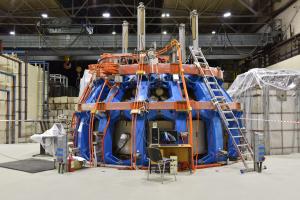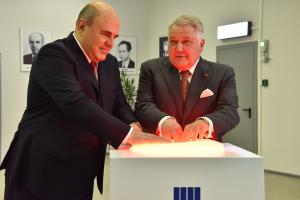T-15MD comes on line in Russia
Sixty-three years after a team at the Kurchatov Institute in Moscow built the world's first tokamak, experiments are slated to begin there on a new machine, T-15MD. This versatile, mid-sized device is designed to support preparations for ITER operation, but not only.
In Moscow on 18 May, participants to the T-15MD launch ceremony lauded the start of the "first new fusion installation at the Kurchatov Institute in 20 years." Russian Prime Minister Mikhail Mishustin and Mikhail Kovalchuk, President of the Kurchatov Institute, pressed a symbolic start button and spoke over video link with Bernard Bigot, the Director-General of the ITER Organization, who congratulated them on the facility's launch.
T-15MD is a new machine created in the place of the T-15 tokamak—Russia's second superconducting tokamak (after T-7), which operated at the Kurchatov from 1988 to 1995. The original machine was entirely disassembled in 2017 and all major components were modernized, from auxiliary plasma heating and current drive systems to the new, non-superconducting silver-copper magnet systems and graphite inner surfaces. The upgraded Russian tokamak will extend the operational domain of "ITER-complementary" machines, with an experimental program that will contribute to the determination of optimal operating parameters for ITER and for future fusion reactors.
The T-15MD tokamak can obtain elongated one- and two-zero divertor configurations of a plasma column, with an aspect ratio* in the range of 2.2 to 3.1 and elongation up to 1.9. Its water-cooled electromagnetic system is capable of creating a toroidal magnetic field at the plasma axis of 2 T; it also has powerful quasi-stationary additional heating systems with a total power input into the plasma up to 20 MW, and modern engineering infrastructure. The current in the plasma should reach 2.0 MA with a duration of 10 s. Tokamak T-15MD was built over 10 years (2011-2020).
The uniqueness of T-15MD lies in its combination of high power and compact dimensions. High-performing auxiliary plasma heating and current drive systems will allow the simultaneous achievement of high plasma temperature and plasma density, with pulse lengths of up to 30 s. The machine will be a test bed for different auxiliary heating scenarios through its capabilities in neutral beam injection, electron cyclotron resonance heating (six gyrotrons), ion cyclotron resonance heating (three antennas), and low hybrid heating and current drive, as well as a test bed for fusion material studies.
The research program on the T-15MD tokamak will be aimed at solving the most pressing problems of ITER, such as the mechanism of formation and maintenance of transport barriers, the stationary generation of non-inductive current, heating and retention of a hot plasma, control of processes on the first wall and in the divertor, and the suppression of global instabilities and periodic energy emissions on the wall.
Experiments on T-15MD will also pursue another line of investigation, according to the Kurchatov team—using the neutrons generated in this mid-sized tokamak to explore the feasibility of a hybrid fusion/fission model. In a hybrid model, neutrons generated by the fusion reactions incite fission in otherwise non-fissile fuels contained in the blanket of the vessel. Alternately, they are used to transmutate long-lived high-level waste products from nuclear fission (actinides) into shorter-lived products.
"T-15MD will be the major fusion experiment in the Russian Federation for the next 7 to 10 years," says Anatoly Krasilnikov, head of the Russian Domestic Agency. "Its operation will provide support to the ITER project not only through studies of some aspects of tokamak physics and technology, but also by teaching a new generation of plasma scientists and engineers. In addition, several new fusion plasma technologies important for future reactors, such as a liquid lithium first wall and divertor components and noninductive current drive, will be further developed and studied at T-15MD."
Physical start-up will be pursued through the production of low-temperature plasma demonstrating the operability of all technological systems before a gradual increase in the discharge current and, as a consequence, the plasma temperature. Work with high-temperature plasma on T-15MD will begin late in 2021.
* Ratio of the major radius to the minor radius of the toroidal plasma; on ITER the aspect ratio is approximately 3.



